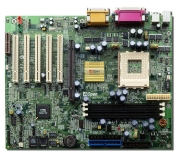Overclocking
I described
the low overclocking ability of the AK33 as its Achiles heel. Things are better
with the AK73 but unfortunately they aren't perfect. I tested with two CPUs:
a Duron 600 that has reached 950 MHz and a Duron 800 that also reaches 950
MHz. Whenever I chose any multiplier over 7.5 with the onboard dip switch
I would get an error from Dr. Voice stating "There may be a problem with
your AGP". I disabled AGP 4x since there is a lot of speculation that
the VIA chipsets are having problems with that. That didn't fix the problem.
After a couple of hours I finally was able to figure out where the problem
was originating. In order to reach the higher speeds that both of my CPUs
are capable of I would have to adjust the CPU voltage higher than the stock
1.5v. Here's the problem though: every time you make an adjustment via the
onboard dip switch the CPU voltage setting in the BIOS is reset to the stock
1.5v. A couple of times I was able to get access to the BIOS just long enough
to up the voltage and save the setting. Even though the Duron 600 has had
no problems posting @ 950 MHz on another board I simply couldn't get it past
800 MHz before the CPU voltage problem popped up. Things weren't much better
for the Duron 800 as I maxed out at 900 MHz.
 With
the multiplier maxed out I was able to further step up the Duron 600 to 840
MHz by upping the FSB to 105 MHz. The Duron 800 could only get up to 104 FSB
with the final result of 936. That is pretty close to its peak of 950 MHz
but I was disappointed by the fact it took so much work to try and get these
CPUs up to these speeds. Solution? Axe the dip switch and perform all changes
within the BIOS. With many boards this is the perfect setup since the voltage
can be altered at the same time that the multiplier is adjusted. If it doesn't
boot just go back to the stock settings until you find a setting that works.
That's a lot easier than crawling under your desk to adjust those little switches.
With
the multiplier maxed out I was able to further step up the Duron 600 to 840
MHz by upping the FSB to 105 MHz. The Duron 800 could only get up to 104 FSB
with the final result of 936. That is pretty close to its peak of 950 MHz
but I was disappointed by the fact it took so much work to try and get these
CPUs up to these speeds. Solution? Axe the dip switch and perform all changes
within the BIOS. With many boards this is the perfect setup since the voltage
can be altered at the same time that the multiplier is adjusted. If it doesn't
boot just go back to the stock settings until you find a setting that works.
That's a lot easier than crawling under your desk to adjust those little switches.
Conclusions
 The
AK73 wasn't a disappointment in its performance or stability. It offers good
expansion with 5 PCI slots and 4 USB ports. Had I not run into the problem
trying to overclock my processors I think I would have been very comfortable
letting this board be my editor's choice. Rather, I decided to award the AK73
Pro with the TargetPC Approved award simply because it does offer some nice
improvements over the AK33 and the other KT133 based boards we've tested.
The top of the list would be its larger expansion possibility due to the extra
2 USB ports and the fact that the board comes equipped with Dr. Voice instead
of making it another option to spend money on. Another thing to consider is
that this board already features ATA-100 support so that is one less card
to pack into your PCI slots just to get the most out of your harddrive.
The
AK73 wasn't a disappointment in its performance or stability. It offers good
expansion with 5 PCI slots and 4 USB ports. Had I not run into the problem
trying to overclock my processors I think I would have been very comfortable
letting this board be my editor's choice. Rather, I decided to award the AK73
Pro with the TargetPC Approved award simply because it does offer some nice
improvements over the AK33 and the other KT133 based boards we've tested.
The top of the list would be its larger expansion possibility due to the extra
2 USB ports and the fact that the board comes equipped with Dr. Voice instead
of making it another option to spend money on. Another thing to consider is
that this board already features ATA-100 support so that is one less card
to pack into your PCI slots just to get the most out of your harddrive.
The biggest disappointment with
the AK73 was its difficult overclocking. I know for a fact that both my CPUs
had more in them, especially the Duron 600. 840 MHz is quite a bit shy of
the 950 MHz performance it is capable of. That also brings up the fact that
using a 105 MHz FSB moves my AGP and PCI buses that much more out of spec.
I'll keep looking around for a SocketA board that offers great overclocking
and has some of the AK73's neat features.
Victor
Oshiro January 23, 2001
